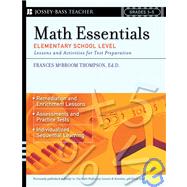
| Notes to the Teacher | |
| Numeration and Number Properties.Objectives | |
| Order three or more whole numbers up to ten thousands | |
| Identify odd and even whole numbers | |
| Form a generalization of the pattern found in a given ordered set (or sequence) of whole numbers, then generate more members of that set using that generalization | |
| Round whole numbers to the nearest ten, hundred, or thousand | |
| Represent a proper fraction with various models (physical, pictorial) | |
| Find equivalent fractions that are less than one | |
| Compare and order two proper fractions, using models (physical, pictorial) | |
| Match numerals or number names of decimals involving tenths and hundredths with their equivalent word names (including mixed numbers).Practice Test | |
| Computational Algorithms and Estimation in Problem Solving.Objectives | |
| Add or subtract whole numbers (two-digit to four-digit) to solve a word problem | |
| Multiply two-digit whole numbers by one-digit or two-digit whole numbers (as multipliers) to solve single-stepped word problems | |
| Divide two-digit or three-digit whole numbers by one-digit whole numbers (as divisors) to solve a single-stepped word problem | |
| Solve multistepped word problems, using addition, subtraction, multiplication, or division of whole numbers | |
| Estimate a solution to a word problem, using rounding and whole number addition with two or more addends | |
| Estimate a solution to a word problem, using rounding and subtraction of whole numbers | |
| Estimate a solution to a word problem, using rounding and multiplication of whole numbers | |
| Add or subtract four-digit decimals (tens to hundredths).Practice Test | |
| Graphing, Statistics, and Probability.Objectives | |
| Complete a two-column (or two-row) numerical table, using recognized patterns in the column (or row) entries, in order to solve word problems | |
| Identify a set of points on a number line, using greater than and less than | |
| Find the mean of a set of data | |
| Construct, interpret, and apply pictographs | |
| Construct, interpret, and apply (single) bar graphs | |
| Construct, interpret, and apply (broken) line graphs | |
| Use a pair of numbers to compare favorable outcomes to all possible outcomes of a single-staged experiment or situation, and identify which outcome has the greater chance of occurring | |
| Identify possible two-member or three-member outcomes of a situation (multistaged experiment without order).Practice Test | |
| Geometry and Logical or Spatial Reasoning.Objectives | |
| Make generalizations from geometric sets of examples and nonexamples | |
| Use reflections to identify planar shapes having a line of symmetry | |
| Identify congruent planar shapes by using rotations, reflections, or translations | |
| Identify polygons by their generic names | |
| Identify right, acute, and obtuse angles | |
| Describe rectangles (including squares) by their characteristics (sides, diagonals, angles) | |
| Identify three-dimensional shapes (solids) by their names and by specific characteristics, such as faces, vertices, or edges | |
| Apply logical reasoning to solve a word problem (with or without computation).Practice Test | |
| Measurement.Objectives | |
| Estimate the length of an object, using an appropriate measuring unit (inch, foot, yard, millimeter, centimeter, meter) | |
| Estimate the capacity of a container, using an appropriate measuring unit (milliliter, liter, cup, pint, quart, gallon) | |
| Estimate the weight of an object, using an appropriate measuring unit (ounce, pound, gram, kilogram) | |
| Define the relationship between two units of measure within the same system of measurement | |
| Solve problems that involve the passing of time and the notation for time shown o | |
| Table of Contents provided by Publisher. All Rights Reserved. |
The New copy of this book will include any supplemental materials advertised. Please check the title of the book to determine if it should include any access cards, study guides, lab manuals, CDs, etc.
The Used, Rental and eBook copies of this book are not guaranteed to include any supplemental materials. Typically, only the book itself is included. This is true even if the title states it includes any access cards, study guides, lab manuals, CDs, etc.